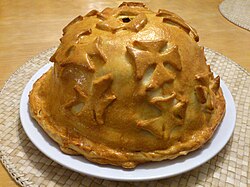Kurnik (pirog)
 | |||||||
| Type | Pirog | ||||||
|---|---|---|---|---|---|---|---|
| Place of origin | Russia | ||||||
| Associated national cuisine | Russian cuisine | ||||||
| Main ingredients | Chicken, eggs, onions, kasha or rice | ||||||
| Variations | Chicken and mushroom pie | ||||||
| 536[1] kcal | |||||||
| |||||||
Kurnik (Russian: курник; "chicken pirog"), also known as wedding pirog or tsar pirog, is a dome-shaped savoury Russian pirog usually filled with chicken or turkey, eggs, onions, kasha or rice, and other optional components. Sometimes filled with boiled rooster combs,[1][2][3] this pirog originated in Southern Russia, especially in Cossack communities, and was used as a "wedding pirog" in the rest of the country.[2][3] It is dome-shaped, unlike any other non-sweet pirog. In special cases, it was served to tsar himself. Even today, this pirog is served on special occasions in most of Russia.[3]
Customs[]
For a wedding, kurniks were made for both spouses. The groom's pirog was decorated with figures of people representing the strength of the young family. The bride, on the other hand, had her kurnik decorated with flowers, said to represent beauty and kindness.[3]

Kurnik filled with slices of chicken, mushrooms, blini, rice, eggs
See also[]
References[]
- ^ a b Jamie Oliver. Kurnik. Jamieoliver.com. 25 Jan. 2017.
- ^ a b Вильям Похлебкин. Кулинарный словарь, Курник. Москва: Центрполиграф, 2007, ISBN 978-5-9524-3170-6 (William Pokhlyobkin. The Culinary Dictionary, "Kurnik". Moscow: Centrpoligraph, 2007; in Russian)
- ^ a b c d Леонид Зданович. Кулинарный словарь, Курник. Москва: Вече, 2001, ISBN 5-7838-0923-3 (Leonid Zdanovich. Culinary dictionary, "Kurnik". Moscow: Veche, 2001; in Russian)
- Russian chicken dishes
- Savoury pies
